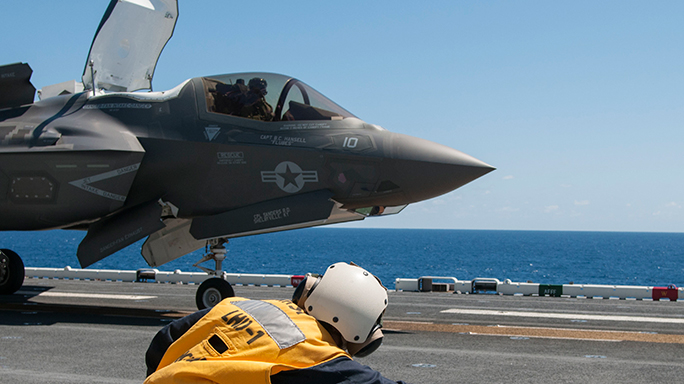The following is a release from Marine Corps Headquarters:
The U.S. Marine Corps’ F-35B Lightning II aircraft reached initial operational capability (IOC) on July 31, 2015 with a squadron of 10 F-35Bs ready for world-wide deployment.
Marine Fighter Attack Squadron 121 (VMFA-121), based in Yuma, Ariz., was the first squadron in military history to become operational with an F-35 variant after completing years of developmental and operational testing, followed by an intensive Operational Readiness Inspection (ORI). This ORI, which included a capstone surge day, demonstrated that the aircraft and squadron have successfully met all IOC criteria.
Advertisement — Continue Reading Below
“Marine Corps IOC for the F-35B is a significant accomplishment, but we will not stop to celebrate. In addition to aggressively continuing to mature this platform, we will further refine the operational concepts that allow us to fully leverage this transformational capability,” said Gen. Joseph Dunford in a July 2015 statement, when he was serving as Commandant of the Marine Corps. “It is capable of conducting close air support, offensive and defensive counter air, air interdiction, assault support escort and armed reconnaissance as part of a Marine Air Ground Task Force, or in support of the Joint Force.”
Dunford added that the F-35B’s ability to conduct operations from expeditionary airstrips and sea-based carriers provides our nation and its allies with our first 5th generation strike fighter, which will transform the way the Navy-Marine Corps team fights as a Marine Air-Ground Task Force
The Marine Corps has a program of record to procure 353 F-35Bs and 67 F-35Cs, for a total of 420 aircraft. As the future of Marine Corps tactical aviation, the F-35 will eventually replace three legacy platforms: the AV-8B Harrier, the F/A-18 Hornet, and the EA-6B Prowler. The transition is scheduled to be complete for active duty
Advertisement — Continue Reading Below
Marine Corps aviation squadrons in fiscal year 2031. It is not a one-for-one swap. Because of the enhanced capabilities of the F-35, this strike fighter will replace a significantly greater number of legacy aircraft.
“The performance of VMFA-121, and the entire Marine Corps F-35B team over the past several years, has reinforced my feeling that we not only have great Marines in this program, but that we are giving them the right aircraft,” said Lt. Gen. Jon Davis, Deputy Commandant for Aviation.
Harrier squadrons will gradually transition to F-35 squadrons over the next 11 years. The planned sundown for the AV-8B is in 2026. This is, however, subject to review, assessment and final decision in 2019.
Advertisement — Continue Reading Below
Marine Corps Hornet squadrons will gradually transition to F-35 squadrons over the next fifteen years. The planned sundown for the Marine Corps F/A-18 is in 2030. As with the Harrier, this is subject to review, assessment and final decision in 2019.
The four EA-6B squadrons at Cherry Point, North Carolina will begin retiring their Prowlers at the rate of one squadron per year, beginning in 2016.
“We intend to extract maximum value and service life out of our Harriers, Hornets and Prowlers,” added Davis.
Advertisement — Continue Reading Below
The U.S. Marine Corps has trained and qualified more than 50 Marine F-35B pilots and certified about 500 maintenance personnel to assume autonomous, organic-level maintenance support for the F-35B.
VMFA-121’s recent operational status will be followed by Marine Attack Squadron 211 (VMA-211), an AV-8B squadron, which is scheduled to receive their first F-35Bs in 2016, and become fully operational within two years. In 2018, VMFA-122, an F/A-18 squadron in Beaufort, South Carolina, will begin conducting its transition to the F-35B. Another Hornet squadron, VMFA-115, will start transitioning to the F-35 in early 2020. VMA-311 is scheduled to follow suit later that year.
The F-35’s fifth-generation air superiority preserves U.S. national security and ensures optimum international security across the globe as integrated coalition operations enable the U.S., United Kingdom, Italy, the Netherlands, Turkey, Canada, Australia, Denmark, Norway, Japan, Israel and South Korea to fight shoulder-to-shoulder with an unrivaled first-look, first-shot, first-kill capability.
Advertisement — Continue Reading Below
























